
Argeș County is a county (județ) of Romania, in Muntenia, with the capital city at Pitești.

Târgoviște is a city and county seat in Dâmbovița County, Romania. It is situated 80 kilometres north-west of Bucharest, on the right bank of the Ialomița River.

Curtea de Argeș is a municipality in Romania on the left bank of the river Argeș, where it flows through a valley of the Southern Carpathians, on the railway from Pitești to the Turnu Roșu Pass. It is part of Argeș County. The city also administers one village, Noapteș.

Câmpulung, or Câmpulung Muscel, is a city in Argeș County, Muntenia, Romania. It is situated among the outlying hills of the Southern Carpathians, at the head of a long well-wooded glen traversed by the river Târgului, a tributary of the river Argeș.
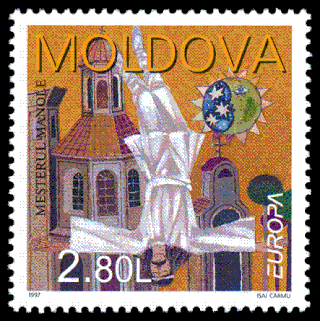
In Romanian mythology, Meșterul Manole was the chief architect of the Curtea de Argeș Monastery in Wallachia. The myth of the cathedral's construction is expressed in the folk poem Monastirea Argeșului.
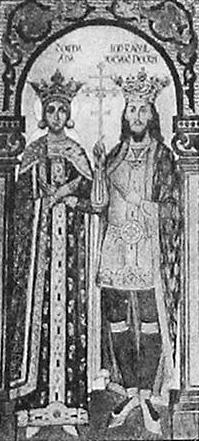
Radu I was a Voivode of Wallachia. His year of birth is unattested in primary sources. He was the son of Nicolae Alexandru and half-brother and successor to Vladislav I. He is identified by many historians as the legendary Radu Negru, a mythical voievode of the early medieval state Wallachia, founder of the state's institutions and ruler.

Negru Vodă is a town in Constanța County, Northern Dobruja, south-eastern Romania. The town is close to the border with Bulgaria and there is a border crossing linking Negru Vodă to the Bulgarian village Kardam. It officially became a town in 1989, as a result of the Romanian rural systematization program.

The Cathedral of Curtea de Argeș is a Romanian Orthodox cathedral in Curtea de Argeș, Romania. It is located on the grounds of the Curtea de Argeș Monastery, and is dedicated to Dormition of the Mother of God. The building is the seat of the Archdiocese of Argeș and Muscel.

Negru Vodă, also known as Radu Negru, is the legendary founder of Wallachia.

Iustin Moisescu was Patriarch of the Romanian Orthodox Church from 1977 to 1986.

Aninoasa is a commune in Dâmbovița County, Muntenia, Romania. It is composed of three villages: Aninoasa, Săteni and Viforâta. It is situated in the historical region of Muntenia.

Poiana Lacului is a commune in Argeș County, Muntenia, Romania. It is composed of thirteen villages: Cătunași, Cepari, Dealu Orașului, Dealu Viilor, Dinculești, Gălețeanu, Gărdinești, Gâlcești, Metofu, Păduroiu din Deal, Păduroiu din Vale, Poiana Lacului, and Sămara.
The founding of Wallachia, that is the establishment of the first independent Romanian principality, was achieved at the beginning of the 14th century, through the unification of smaller political units that had existed between the Carpathian Mountains, and the Rivers Danube, Siret and Milcov.
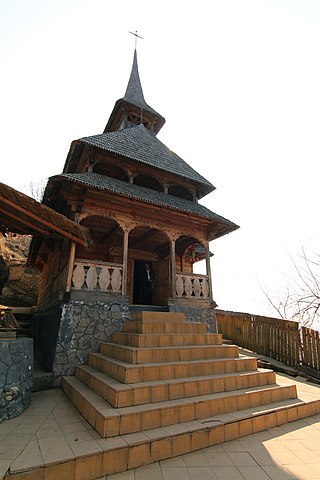
Cetățeni is a commune in Argeș County, Muntenia, Romania. It is composed of three villages: Cetățeni, Lăicăi, and Valea Cetățuia.
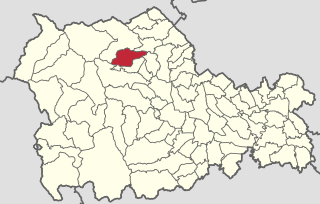
Agapia is a commune in Neamț County, Western Moldavia, Romania. It is composed of four villages: Agapia, Filioara, Săcălușești and Văratec. At the 2002 census, 100% of inhabitants were ethnic Romanians, and 99.2% were Romanian Orthodox. The commune is the site of Agapia Monastery and Văratec Monastery.
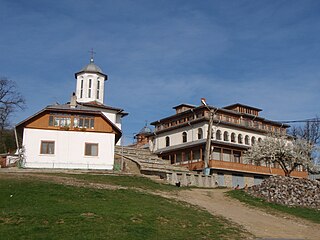
Dealu Mare Monastery is a Romanian Orthodox monastery in Romania, located in the commune of Borăscu, Gorj County.

Holy Trinity Monastery is a Romanian Orthodox monastery in Romania, located in Strâmba-Jiu village, Turceni town, Gorj County, Romania.

Ghenadie Petrescu was a Wallachian, later Romanian priest of the national Orthodox church, who served as Metropolitan-Primate of Romania from 1893 to 1896. Ghenadie was a monk and hieromonk steadily progressing through church ranks, and becoming Bishop of Argeș in 1875. While tending to this congregation, he established his reputation as philanthropist, art patron, and writer on historical subjects. Ghenadie also preserved an interest in politics, espousing a nationalist Orthodox agenda and finding himself allies on both sides of Romania's two-party system, Conservative and National Liberal.

The Centenary March or Centenary March of the Great Union was a civic demonstration organized by George Simion and various non-governmental organizations from Romania and Moldova, known under the collective name "Alliance for the Centenary". It started in Alba Iulia (Romania) on 1 July 2018 and ended in Chișinău (Moldova) on 1 September 2018. Its participants, both Moldovans and Romanians, targeted 300 cities and villages, passing through several points significant for the Great Union.

Neo-Legionarism is a neo-fascist movement in Romania that emerged in the 1990s following the fall of communism in the country. It is endorsed by a series of organizations that claim to be the successors of the Iron Guard founded by Corneliu Zelea Codreanu in 1927. Its main characteristics include antisemitism, Eastern Orthodoxy, ethnic nationalism and mysticism.



















